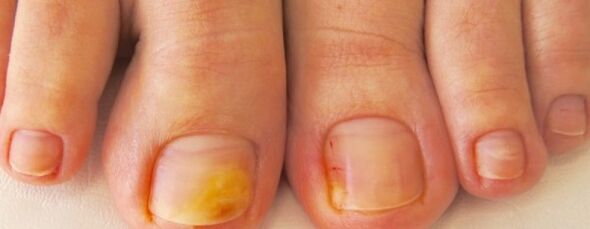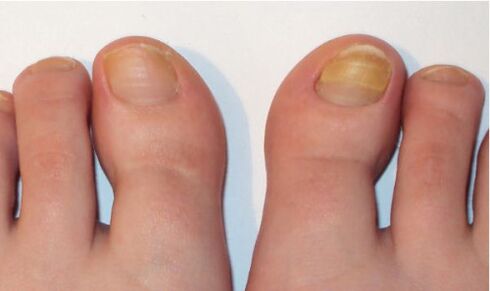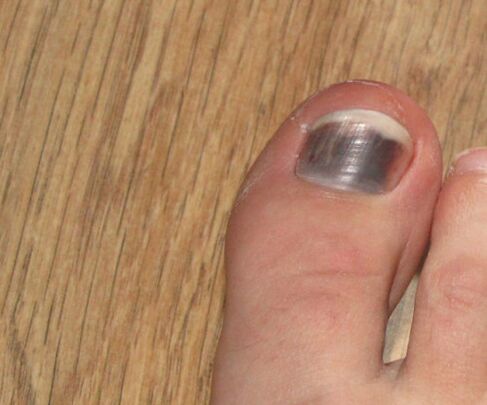Most people do not know that the most common sweat on the feet and the unpleasant odor that accompanies it is one of the main signs of the development of fungal diseases. Toenail fungus, a symptom that does not appear immediately, can appear in anyone who does not take care of himself at least a little bit. The disease awaits almost everywhere, and most often in public places. What is sad is that fungal diseases are quite dangerous: they are treated for a long time and are ineffective in 100% of cases, as they are characterized by relapse. To identify fungus in a timely manner and begin treatment, you need to have an idea of how toenail fungus manifests itself.

The spread of fungal diseases
The disease is caused by the development of parasitic fungi in the body. The best conditions for subsequent emergence and spread are a warm environment at the same time as high humidity. Many think that it is very easy to get such an infection in water parks, baths, beauty salons.
But the statistics are completely different: you can get a fungal infection even without leaving your home through shared items (bathroom, clothes, shoes, towels). However, this is true if at least one member of the household is a carrier of the fungus. However, what fundamentally affects the spread of the fungus? There are important aspects that cause infections with fungal diseases:
- Strong sweating;
- diabetes;
- Problems of overweight;
- If the nail is injured;
- Weak immunity.
To protect yourself from fungal infections, you just need to use personal hygiene products, do a thorough treatment for bathing and showering, just put on your shoes, arrange carpet washing as often as possible, etc. And if you have noticed the first signs of toenail fungus, you should immediately contact a dermatologist!
Signs of fungus, based on the causative agent of the disease

Signs of fungus on toenails need to be observed in time. The effectiveness of complex treatment of fungal infections is determined by the extent to which the causative agent of the disease is correctly identified. This can be explained by the fact that there are many types of fungi, and each species responds to a specific group of drugs.
In most cases, the causative agents of the disease are:
- reference;
- Dermatophytes;
- Yeast.
If the fungus starts to grow because of yeast, then it is almost impossible to detect the disease overnight. The signs of fungus on the feet in such conditions are as follows:
- Feet and skin around the nail plate itch;
- Peeling nails.
Yeast infections occur in only 4-5% of cases. Most often, it is dermatophytes that affect the nail plate (94. 5%). These pathogens are of 3 types, and the manifestations of each are very different:
- 1 type. There is a simultaneous defeat on the nail plate, the skin of the foot and the foot as a whole. Such fungi easily move to the nails and skin of the hands.
- 2 types. The disease only affects the nails of the thumb and little finger on the feet. Can also go to the folds between the fingers.
- 3 types. It is characterized by damage to the nail plates of the little finger and thumb, but the disease does not spread to the skin.
As for mold, the causative agent in this case is a mold fungus. It is observed very rarely. Often found in AIDS patients.
Other symptoms

Often, when the disease is just beginning to develop, there are no symptoms of fungus on the toenails. But in case of extreme attention on one’s feet, one will notice that round spots begin to appear on the nail plate, and the nail itself loses its luster and becomes rough. Developing, fungal diseases affect the nail plate to a greater extent: its color will initially change, after which the nail peels off, it can break easily. The shade of the nail plate is determined by the type of pathogenic fungus.
Toenail fungus: symptoms (additional)
- The nail plate turns black;
- The nail takes on an unusual shape, and its structure changes completely;
- Nails become very brittle;
- Plastic pieces of nails under the skin;
- Followed by constant fatigue.
The appearance of an abnormal nail plate is a "bell" to visit a dermatologist, and there the nail fungus, the symptoms of which you notice, will be confirmed or refuted. If you constantly delay going to the doctor, the disease will quickly spread to other areas. If you don’t think about it, then there is nothing life threatening in this disease. But, in addition to aesthetic problems and discomfort exclusively, fungal infections are sometimes a great cause of complications. For this reason, symptoms should not be ignored and treatment of the disease should be started in a timely manner, as soon as it is identified.
Doctors who treat fungal diseases
It is realistic to detect the infection yourself, but only a doctor can confirm your guess. To make an accurate diagnosis, a dermatologist will recommend specific tests. For its implementation, a piece of destroyed nail plate or scraping of periungual tissue is taken.
Timely detected infections make further treatment easier and eliminate the possibility of complications. If treatment is not started at the right time, this will ensure the spread of the disease to other organs and all fingernails / toenails.
Toenail fungus: treatment procedures
Therapies aimed at treating the fungus are prescribed by a dermatologist - everything will depend on how advanced the disease is, the type of fungus present in the body and other factors. Usually, if a new fungus begins to grow, medications are prescribed for external use. In more difficult situations use intensive care.
By the way, it takes a lot of time. Therefore, it is in your best interest to visit a doctor with the slightest suspicion of a fungal infection! Symptoms of nail fungus must be known in advance. And the sooner the disease is detected, the sooner treatment will take place!





























